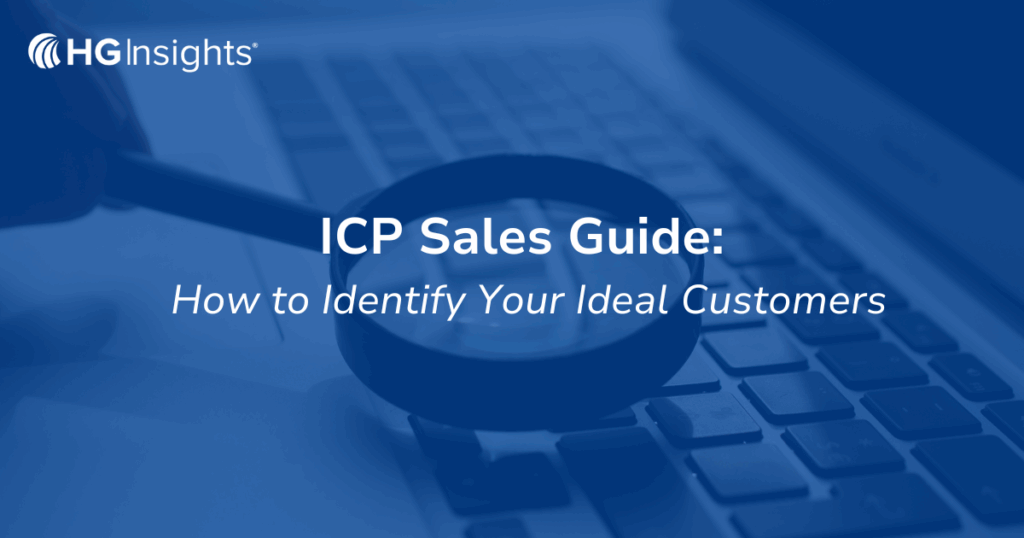Sales teams today are faced with the herculean task of turning a long list of prospects into valuable customers and consistently increasing annual revenue. It’s no easy feat. But the first step to achieving this is to have a well-defined Ideal Customer Profile (ICP).
However, creating an accurate ICP requires access to comprehensive, reliable data and alignment around the characteristics that make up the company’s ICP. This is where HG Insights comes in. We provide a powerful platform that delivers granular market and account-level data into companies’ technology landscape for data-driven ICP development.
In this article, we’ll dive into the concept of an ICP in sales and outline the steps to create a data-driven sales ICP. We’ll also showcase how HG Insights can empower your sales team to identify high-value accounts, improve efficiency, and ultimately, achieve revenue goals.
ICP Meaning in Sales
To create a successful sales strategy, it’s crucial to have a clear picture of your ideal customer. Otherwise you risk wasting time and resources chasing prospects who will never buy your product.
An ICP is a detailed description of the perfect customer for your product or service. A well-defined ICP helps identify accounts that have the highest potential to become loyal, long-term customers who bring the most revenue over time – also known as demonstrating lifetime value (LTV). By focusing on accounts that fit your ideal customer profile, sales teams can prioritize efforts around prospects who are likely to convert, make repeat purchases, and grow their value to the business.
An ICP in sales usually includes firmographic data points around company size, industry, location, and revenue. A comprehensive ICP goes further by defining your ideal customer’s technology landscape and buying behavior. This includes information around installed technologies, IT budget, cloud maturity, and the presence of a competitor or partner product.
Many people confuse ICPs with buyer personas, but they’re actually quite different. While an ICP focuses on the characteristics of an ideal company, a buyer persona represents a specific individual within that company who is involved in the purchasing decision. Buyer personas include details like job title, responsibilities, pain points, and goals.
In short, an ICP helps you identify target accounts, while buyer personas guide your messaging and outreach to the decision-makers within those accounts.
The Importance of an ICP in Sales
Having an ICP that includes all these elements is essential for sales teams to improve their efficiency. Here are few of the ways it optimizes the sales process:
Focus on High-Value Accounts
Instead of wasting time and resources on companies that are unlikely to convert, sales reps can prioritize accounts that closely match their ICP. This targeted approach leads to higher conversion rates, shorter sales cycles, and ultimately, more revenue.
Personalize Messaging
Having a clear ICP helps sales teams create more personalized and relevant messaging. By understanding the specific pain points, goals, and characteristics of their ideal customers, reps can tailor their outreach to resonate with each prospect. This level of personalization builds trust and credibility, making prospects more receptive to the sales pitch.
For example, consider a software company that sells a marketing automation platform. By defining their ICP as mid-sized B2B companies with a dedicated marketing team and a focus on inbound lead generation, the sales team can create targeted content and demos that showcase how their platform solves the specific challenges these companies face. This approach is far more effective than a generic pitch that fails to address the unique needs of each prospect.
Sales and Marketing Alignment
Another benefit of having a well-defined ICP is improved alignment between sales and marketing. When both teams are working towards the same ideal customer, they can create a seamless experience that guides prospects through the buyer’s journey. Marketing can create content and campaigns that attract and nurture ICP leads, while sales can focus on closing those high-value opportunities.
The ROI of a Sales ICP
Implementing an ICP has proven successful for countless companies. Consider these ROI metrics that real-world companies have seen once they implemented a sales ICP:
- Win Rates Improve: Companies with a well-defined ICP experience a 68% higher account win rate.
- Deal Sizes Are Larger: Sales teams leveraging ICPs report a 45% increase in average deal size.
- Sales Productivity Increases: Businesses with a clear ICP report a 28% increase in sales productivity.
- Customer Retention Improves: Companies utilizing ICPs achieve a 36% higher customer retention rate.
- Obtain More Handraisers: Businesses using ICPs see a 32% increase in marketing-qualified leads (MQLs).
The Essential Sales ICP Data Points
To create an effective ICP, you need to analyze several data points. These can come from both first and third-party providers:
- Firmographics: Basic company information like industry, size, location, and revenue.
- Technographics: The technologies and software a company uses, IT spending budget, and cloud maturity can indicate their needs and priorities.
- Fit and value: How well a company aligns with your product or service, and the potential value they could gain from it.
By combining these elements, you can create a robust, data-driven ICP that helps your sales team focus on the most promising opportunities.
Steps to Create a Revenue-Driving Sales ICP
Creating an ICP requires a systematic approach that analyzes both the qualitative and quantitative data points listed above. Here’s a step-by-step guide to developing an ICP that will help your sales team focus on the right opportunities and close more deals.
Step 1: Analyze Your Best Customers
Start by identifying your most successful customers – those who have generated the most revenue, have the highest lifetime value, and are the most satisfied with your product or service. Look for common characteristics among these customers, such as industry, company size, location, and technology stack.
Step 2: Gather Qualitative Insights
Conduct interviews with your best customers to gain a deeper understanding of their needs, challenges, and decision-making processes. Ask questions about their business goals, pain points, and what they value most about your offering. This qualitative data will help you create a more detailed and nuanced picture of your ideal customer.
Step 3: Integrate Firmographic and Technographic Data
Firmographic data includes information about a company’s industry, size, location, and revenue. Technographic data provides insights into a company’s technology stack, including the hardware, software, and tools they use. By integrating both types of data, you can identify companies that are similar to your best customers and are more likely to benefit from your product or service.
Step 4: Create Your ICP
Based on the insights gathered from qualitative and quantitative data analysis, create a detailed description of your ideal customer. This should include firmographic, technographic, and behavioral characteristics, as well as key pain points, goals, and challenges. Use this ICP as a guide for your sales team to prioritize accounts and tailor their outreach.
Step 6: Continuously Refine Your ICP
As your business evolves and you gain more customers, it’s important to continuously refine your ICP based on new data and insights. Regularly review your customer data to identify new trends and patterns, and update your ICP accordingly.
By following these steps and leveraging a combination of firmographic, technographic, and behavioral data, you can create a revenue-driving sales ICP that helps your team focus on the right opportunities and close more deals. With a well-defined ICP, your sales team can work more efficiently and effectively, ultimately driving more revenue for your business.
Leveraging HG Insights for ICP Development
With HG, you can access detailed information on over 120 million technology installations, 9+ million companies, and 2,500 products and services. This wealth of data allows you to identify the most promising accounts for your business, based on factors such as IT budget, technology stack, contracts, partners and more.
By integrating firmographic, technographic, and behavioral data into a unified view, HG Insights enables you to build a detailed ICP and prioritize the right accounts in your sales strategy.
So if you’re ready to take your ICP to the next level, it’s time to explore HG Insights’ platform. See how HG Insights can help you achieve your sales goals. Schedule a demo with our team of experts and discover the power of AI-driven GTM data for yourself.





